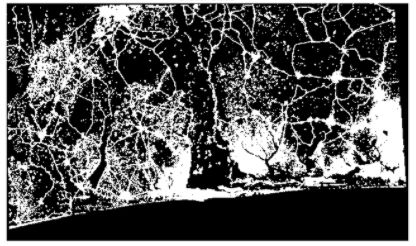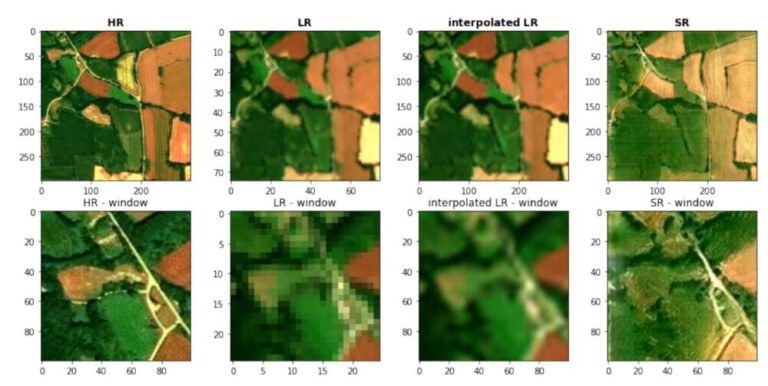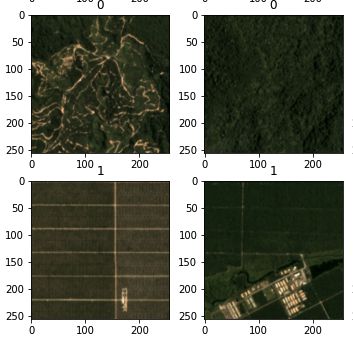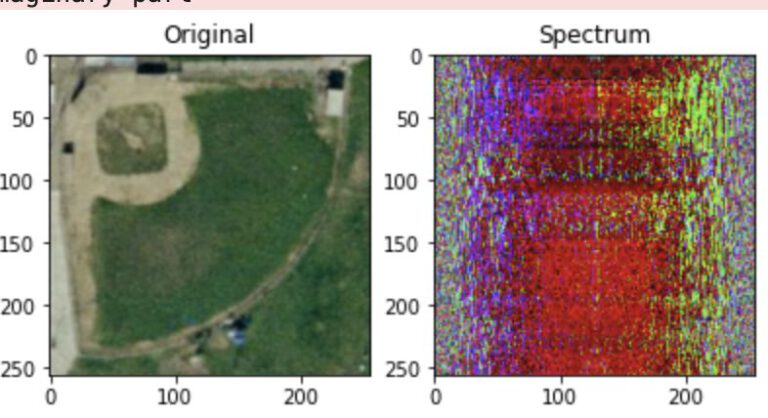Introduction
In this image processing class, some exercises were completed in (Binary) Mathematical Morphology. The binary image in this case is a geotiff representing sealed surfaces (1) or unsealed surfaces (0) in the Golf of Benin, spanning Togo, Benin and Nigeria (Source: Copernicus Global Land Service).
Simple Morphology Operations
Image Processing - Morphology¶
in this notebook, some morphological operations will be performed. First, the image itself and some general information is shown. The map is a binary land cover map, showing sealed surfaces in West Africa (Nigeria, Benin and Togo).
import scipy.ndimage
import rasterio
import skimage.morphology
from matplotlib import pyplot as plt
import matplotlib
# Read image and raster
src = rasterio.open("binary_land_classification_final.tif")
array = src.read(1)
pyplot.imshow(array)
<matplotlib.image.AxesImage at 0x7f039868ad90>
print("GENERAL INFO:")
print("TIF CRS:\t\t",src.crs)
print("Array shape:\t\t",array.shape)
print("Array No. of pixels:\t", array.size)
print("Image data type:\t",array.dtype)
print("Max value of raster:\t",array.max())
print("Min value of raster:\t",array.min())
GENERAL INFO: TIF CRS: EPSG:4326 Array shape: (1057, 1789) Array No. of pixels: 1890973 Image data type: int16 Max value of raster: 1 Min value of raster: 0
from skimage.morphology import (erosion, dilation, opening, closing, white_tophat)
from skimage.morphology import black_tophat, skeletonize, convex_hull_image # noqa
from skimage.morphology import disk
import numpy as np
# define comparison pot (source:https://scikit-image.org/docs/dev/auto_examples/applications/plot_morphology.html#sphx-glr-auto-examples-applications-plot-morphology-py)
def plot_comparison(original, filtered, filter_name):
fig, (ax1, ax2) = plt.subplots(ncols=2, figsize=(25, 15), sharex=True,
sharey=True)
ax1.imshow(original, cmap=plt.cm.gray)
ax1.set_title('original')
ax1.axis('off')
ax2.imshow(filtered, cmap=plt.cm.gray)
ax2.set_title(filter_name)
ax2.axis('off')
# define structuriment, called footprint here
se_left = np.array([[1,0,0,],
[1,0,0,],
[1,0,0]])
plot_comparison(array,erosion(array,se_left),"Erosion left")
# define structuriment, called footprint here
se_right = np.array([[0,0,1],
[0,0,1],
[0,0,1]])
plot_comparison(array,erosion(array,se_right),"Erosion right")
se_disc_2 = disk(2)
print("Structuring Element:\n",se_disc_2)
plot_comparison(array,erosion(array,se_disc_2),"Erosion Disc 2")
Structuring Element: [[0 0 1 0 0] [0 1 1 1 0] [1 1 1 1 1] [0 1 1 1 0] [0 0 1 0 0]]
se_disc_10 = disk(10)
print("Structuring Element:\n",se_disc_10)
plot_comparison(array,erosion(array,se_disc_10),"Erosion Disc 10")
Structuring Element: [[0 0 0 0 0 0 0 0 0 0 1 0 0 0 0 0 0 0 0 0 0] [0 0 0 0 0 0 1 1 1 1 1 1 1 1 1 0 0 0 0 0 0] [0 0 0 0 1 1 1 1 1 1 1 1 1 1 1 1 1 0 0 0 0] [0 0 0 1 1 1 1 1 1 1 1 1 1 1 1 1 1 1 0 0 0] [0 0 1 1 1 1 1 1 1 1 1 1 1 1 1 1 1 1 1 0 0] [0 0 1 1 1 1 1 1 1 1 1 1 1 1 1 1 1 1 1 0 0] [0 1 1 1 1 1 1 1 1 1 1 1 1 1 1 1 1 1 1 1 0] [0 1 1 1 1 1 1 1 1 1 1 1 1 1 1 1 1 1 1 1 0] [0 1 1 1 1 1 1 1 1 1 1 1 1 1 1 1 1 1 1 1 0] [0 1 1 1 1 1 1 1 1 1 1 1 1 1 1 1 1 1 1 1 0] [1 1 1 1 1 1 1 1 1 1 1 1 1 1 1 1 1 1 1 1 1] [0 1 1 1 1 1 1 1 1 1 1 1 1 1 1 1 1 1 1 1 0] [0 1 1 1 1 1 1 1 1 1 1 1 1 1 1 1 1 1 1 1 0] [0 1 1 1 1 1 1 1 1 1 1 1 1 1 1 1 1 1 1 1 0] [0 1 1 1 1 1 1 1 1 1 1 1 1 1 1 1 1 1 1 1 0] [0 0 1 1 1 1 1 1 1 1 1 1 1 1 1 1 1 1 1 0 0] [0 0 1 1 1 1 1 1 1 1 1 1 1 1 1 1 1 1 1 0 0] [0 0 0 1 1 1 1 1 1 1 1 1 1 1 1 1 1 1 0 0 0] [0 0 0 0 1 1 1 1 1 1 1 1 1 1 1 1 1 0 0 0 0] [0 0 0 0 0 0 1 1 1 1 1 1 1 1 1 0 0 0 0 0 0] [0 0 0 0 0 0 0 0 0 0 1 0 0 0 0 0 0 0 0 0 0]]
Dilation¶
se_dilution_disc2 = disk(2)
print("Structuring Element:\n",se_dilution_disc2)
plot_comparison(array,dilation(array,se_dilution_disc2),"Dilation Disc 2")
Structuring Element: [[0 0 1 0 0] [0 1 1 1 0] [1 1 1 1 1] [0 1 1 1 0] [0 0 1 0 0]]
se_dilution_disc10 = disk(10)
print("Structuring Element:\n",se_dilution_disc10)
plot_comparison(array,dilation(array,se_dilution_disc10),"Dilation Disc 10")
Structuring Element: [[0 0 0 0 0 0 0 0 0 0 1 0 0 0 0 0 0 0 0 0 0] [0 0 0 0 0 0 1 1 1 1 1 1 1 1 1 0 0 0 0 0 0] [0 0 0 0 1 1 1 1 1 1 1 1 1 1 1 1 1 0 0 0 0] [0 0 0 1 1 1 1 1 1 1 1 1 1 1 1 1 1 1 0 0 0] [0 0 1 1 1 1 1 1 1 1 1 1 1 1 1 1 1 1 1 0 0] [0 0 1 1 1 1 1 1 1 1 1 1 1 1 1 1 1 1 1 0 0] [0 1 1 1 1 1 1 1 1 1 1 1 1 1 1 1 1 1 1 1 0] [0 1 1 1 1 1 1 1 1 1 1 1 1 1 1 1 1 1 1 1 0] [0 1 1 1 1 1 1 1 1 1 1 1 1 1 1 1 1 1 1 1 0] [0 1 1 1 1 1 1 1 1 1 1 1 1 1 1 1 1 1 1 1 0] [1 1 1 1 1 1 1 1 1 1 1 1 1 1 1 1 1 1 1 1 1] [0 1 1 1 1 1 1 1 1 1 1 1 1 1 1 1 1 1 1 1 0] [0 1 1 1 1 1 1 1 1 1 1 1 1 1 1 1 1 1 1 1 0] [0 1 1 1 1 1 1 1 1 1 1 1 1 1 1 1 1 1 1 1 0] [0 1 1 1 1 1 1 1 1 1 1 1 1 1 1 1 1 1 1 1 0] [0 0 1 1 1 1 1 1 1 1 1 1 1 1 1 1 1 1 1 0 0] [0 0 1 1 1 1 1 1 1 1 1 1 1 1 1 1 1 1 1 0 0] [0 0 0 1 1 1 1 1 1 1 1 1 1 1 1 1 1 1 0 0 0] [0 0 0 0 1 1 1 1 1 1 1 1 1 1 1 1 1 0 0 0 0] [0 0 0 0 0 0 1 1 1 1 1 1 1 1 1 0 0 0 0 0 0] [0 0 0 0 0 0 0 0 0 0 1 0 0 0 0 0 0 0 0 0 0]]
Opening¶
Opening is defined as an erosion followed by a dilation. This removes small bright spots (speckle), thereore removing smaller white lines like roads and small settlements
se_opening = disk(5)
pass_1 = erosion(array,se_opening)
pass_2 = dilation(pass_1,se_opening)
plot_comparison(array,pass_2,"Opening disc 5")
Closing¶
Dilation followed by erosion, removes small black spots, therefore connecting areas that were separated beforem closing gaps in the middle of towns etc.
se_opening = disk(5)
pass_1 = dilation(array,se_opening)
pass_2 = erosion(pass_1,se_opening)
plot_comparison(array,pass_2,"Opening disc 5")
Advanced Operations
Skeleton¶
The skeleton reduces each area to a single pixel wide line along its center.
sk = skeletonize(array == 0)
plot_comparison(array, sk, 'Skeleton')
Hull¶
This function spans a mask around the total area covered by the pixels.
hull = convex_hull_image(array == 1)
plot_comparison(array, hull, 'Hull')




